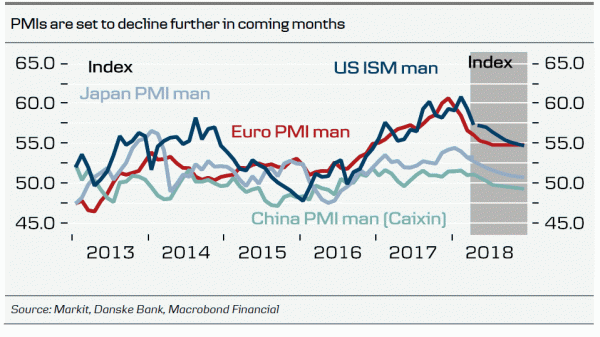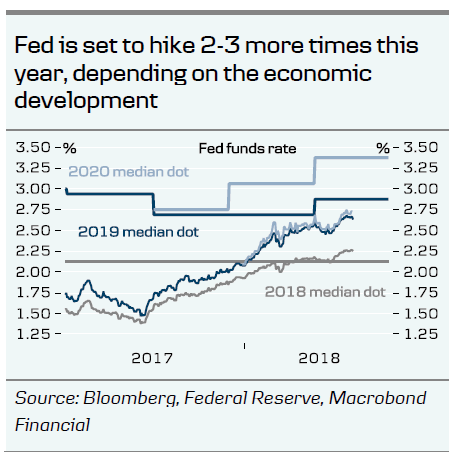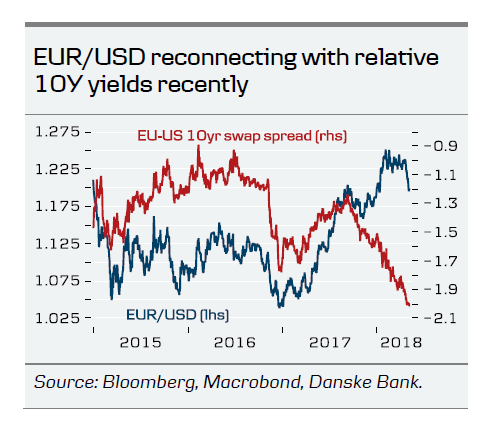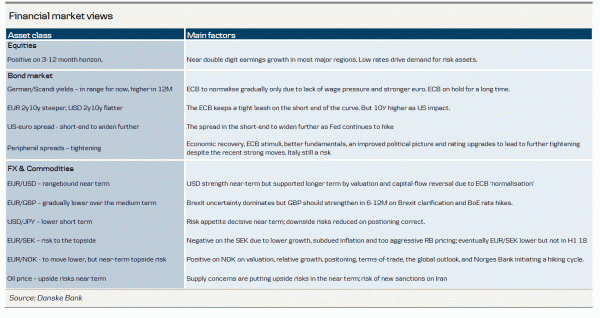Today’s key points
- The trade war is still being slowly fought but the coming weeks are important.
- More signs that growth has peaked but we are not heading for a downturn.
- Fed is on autopilot and EUR/USD has moved below the 1.20 mark.
- EUR/USD may move lower nearterm; medium term still set to move higher
Trade war is still being slowly fought
As we argued back in March, the trade war is being fought very slowly and is more verbal than economic at this stage, see Strategy: Slowly fought trade war amid increasing Libor/OIS spread,, 23 March. The development over the past couple of weeks supports this but the coming weeks are going to be important. The Trump administration has decided to extend the exemption period of steel and aluminium tariffs on the European Union, Mexico and Canada until 1 June to allow for further negotiations. Also, a US delegation with prominent names such as US Trade Representative Robert Lighthizer, Commerce Secretary William Ross and Treasury Secretary Steven Mnuchin went to China in order to find a solution to the trade dispute at the negotiation table. Also, President Trump is going to meet President Xi Jinping in the ‘not too distant future’ to discuss trade. While we do not know the outcome of the talks yet at the time of writing, it seems this will be only the first meeting of a series of meetings, and the US has signalled that the negotiations may take a year or so. A full-blown trade war between the US and China remains the biggest risk factor for markets and the economy.
More signs growth has peaked
During the week, we have gathered more data supporting our view that the business cycle (in terms of growth) has peaked, which we outlined recently in Research: Global business cycle is moving lower,, 19 April. It is not because we believe we are heading for a downturn, just that economic growth is going to be slightly slower than it was in the second half of last year. In the US, the ISM manufacturing index declined from 59.3 to 57.3, which was more than expected. While it was not a big surprise the ISM dropped, as it has been too high compared to other indicators and hard data for quite some time, we still believe it will move further down in three-six months. Also, in Europe, where the manufacturing PMI came out stronger than expected, we believe we will see further declines over the same horizon. The first estimate of euro area Q1 GPP slowed growth slowed from 0.7% q/q in Q4 17 to 0.4% q/q in Q1. While the ECB is likely to end the QE programme this year, we still think the first ECB rate hike is far away, as inflation remains subdued.
Fed on autopilot while EUR/USD may move lower near term
As expected, the Fed maintained the target range at 1.50-1.75% at this week’s meeting but made a couple of interesting changes to the statement, which otherwise does not change much from meeting to meeting. Firstly, the Fed now says that inflation is running near the ‘symmetric’ 2% inflation target, meaning that it will allow inflation to move slightly above 2% (as it also projected back in March). Secondly, it no longer says that it is monitoring inflation closely. In our view, despite the market reaction, we think the Fed was slightly hawkish increasing the probability of three additional hikes this year. Our base case is two-three more rate hikes this year, which is in line with market pricing and the Fed’s own view, as the FOMC members were divided between two and three more hikes in the latest projection update in March. As the hiking cycle is likely to continue next year, we are likely to see the US 2Y10Y curve continuing to flatten, although we do not expect it to invert. Markets are becoming more aware of the spread, as it is seen as one of the best recession indicators. In Europe, we expect a steeper yield curve, as the ECB maintains a relatively tight grip on the short end of the curve, but the 10Y segment of the curve is set to be pushed up by higher US yields, the end of ECB QE and pricing of ECB rate hikes in 2020.
This week EUR/USD broke below the 1.20 mark. In the near term, we may see EUR/USD moving lower on relative rates, flows and positioning, also from a technical point of view with the recent break of the 200D moving average. While relative rates – notably not in the shorter end of the curve – have seemingly failed to move EUR/USD over the past few years, we have seen a clearer reconnect of the 10Y spread with the EUR/USD spot. As US yields are set to increase more than European ones, this should be USD supportive near term. Albeit investors have reduced EUR/USD longs, positioning remains an argument for limited upside in EUR/USD.
However, our medium-term story remains unchanged. A turn in the capital tide from USD to EUR is brewing as the relative attractiveness of EU versus US assets is on the rise. We expect 1.28 in 12M.
















